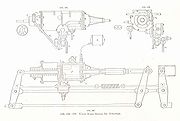
Kunze-Knorr brake
Encyclopedia



Europe
Europe is, by convention, one of the world's seven continents. Comprising the westernmost peninsula of Eurasia, Europe is generally 'divided' from Asia to its east by the watershed divides of the Ural and Caucasus Mountains, the Ural River, the Caspian and Black Seas, and the waterways connecting...
. When it was introduced after the First World War, goods train brakes switched from hand operation to compressed-air in various European countries. The Deutsche Reichsbahn
Deutsche Reichsbahn-Gesellschaft
The Deutsche Reichsbahn – was the name of the German national railway created from the railways of the individual states of the German Empire following the end of World War I....
alone put the cost of equipping German goods wagons with Kunze-Knorr brakes between 1918 and 1927 at 478.4 million Reichsmarks. The operating cost savings from faster goods services and having fewer brakemen was assessed by the Reichsbahn at almost 96.3 million Reichsmark annually.
The Kunze-Knorr brake brought together the ideas of Prussian senior surveyor, Bruno Kunze (1854–1935), and preparatory work by the founder of Knorr-Bremse
Knorr-Bremse
Knorr-Bremse is a manufacturer of braking systems for rail and commercial vehicles that has operated in the field for over 100 years. The company also produces door systems for rail vehicles and torsional dampers. In 2009, the Group's workforce of over 14,000 achieved worldwide sales of EUR 2.761...
, Georg Knorr
Georg Knorr
Theodor Georg Knorr , was an engineer and entrepreneur on the field of railroad technology and founder of the company Knorr-Bremse...
(1859–1911). It was the first, continuous, compressed-air brake that, even on long goods trains, enabled the brake force not only to be applied gradually, but also released again gradually. By combining a single-stage and a two-stage brake cylinder with a compound brake a significant increase in brake effort was achieved.
Three versions of the brake were developed: for goods trains (KKgbr), passenger trains (KKpbr) and express trains (KKsbr). The goods wagon variant offered the option of switching between empty and loaded braking. The passenger train version was given an accelerator valve (Beschleunigungsventil) as well as a control valve. The express train brake had, in addition, a brake pressure regulator in order to prevent the wheels locking when braking quickly.
The Kunze-Knorr brake was developed and manufactured by the firm of Knorr-Bremse AG in Berlin
Berlin
Berlin is the capital city of Germany and is one of the 16 states of Germany. With a population of 3.45 million people, Berlin is Germany's largest city. It is the second most populous city proper and the seventh most populous urban area in the European Union...
. It was also produced by their subsidiary company Süddeutsche Bremsen-AG at what is nowadays the head office of Knorr-Bremse AG
Knorr-Bremse
Knorr-Bremse is a manufacturer of braking systems for rail and commercial vehicles that has operated in the field for over 100 years. The company also produces door systems for rail vehicles and torsional dampers. In 2009, the Group's workforce of over 14,000 achieved worldwide sales of EUR 2.761...
in Munich
Munich
Munich The city's motto is "" . Before 2006, it was "Weltstadt mit Herz" . Its native name, , is derived from the Old High German Munichen, meaning "by the monks' place". The city's name derives from the monks of the Benedictine order who founded the city; hence the monk depicted on the city's coat...
. A total of about 550,000 Kunze-Knorr brake control valves were made, some under licence. In the 1930s they were superseded by the Hildebrand-Knorr brake (Hik brake). In many places, including the Deutsche Reichsbahn in East Germany, they were still regularly in use until the 1960s.
Literature
Wilhelm Hildebrand, Die Entwicklung der selbsttätigen Einkammer-Druckluftbremse bei den europäischen Vollbahnen. Berlin 1927.Jan-Henrik Peters, Personalpolitik und Rationalisierungsbestrebungen der Deutschen Reichsbahn-Gesellschaft zwischen 1924 und 1929. Frankfurt am Main u.a. 1996.
Jan-Henrik Peters, Rationalisierungsbestrebungen der Deutschen Reichsbahn-Gesellschaft zwischen 1924 und 1929, in: Zeitschrift für Unternehmensgeschichte 41, 1996, 187–200.
Manfred Pohl, Sicherheit auf Schiene und Straße. Die Geschichte der Knorr-Bremse AG. (engl. Ausgabe: Safety First by Road and Rail. The History of Knorr-Bremse AG.) München 2005.
External links
- http://www.knorr-bremse.com Website of the Knorr-Bremse company (German)
- http://www.bremsenbude.de Compressed-air brakes on railway vehicles (German)
- There is a relevant English-language forum at Railways of Germany

